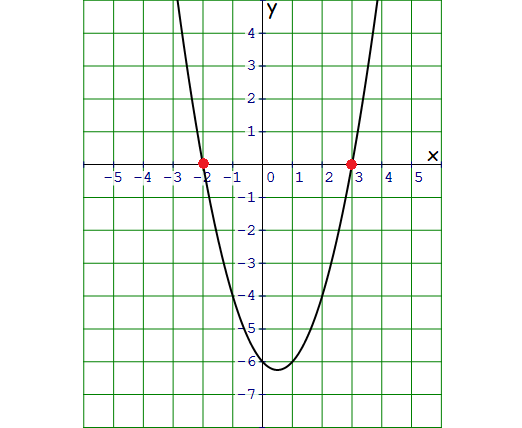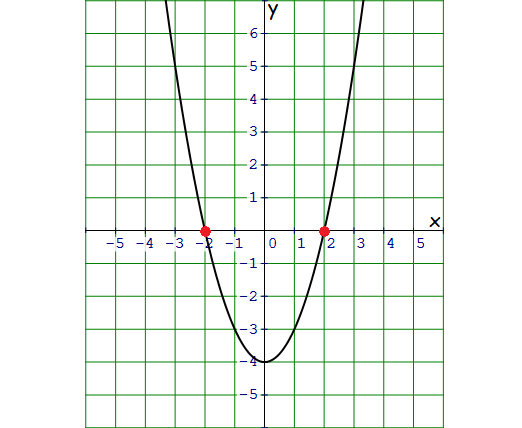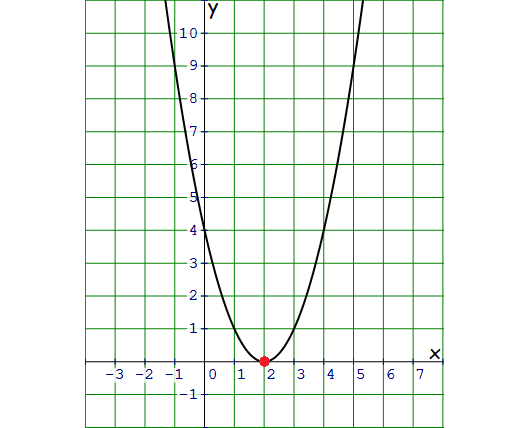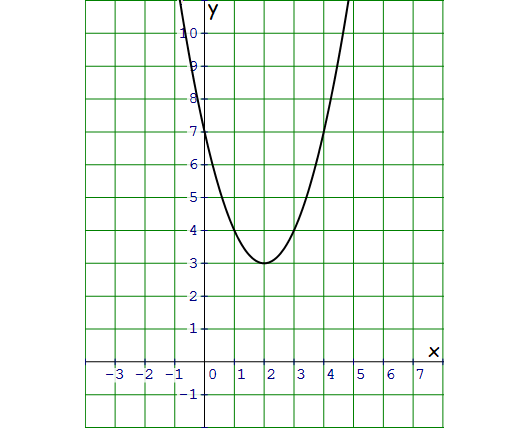X INTERCEPTS OF A QUADRATIC FUNCTION
The graph of a quadratic function is a parabola. When a parabola opens up/down, we may have a chance to have x-intercepts.
x-intercepts are the numbers on the x-axis where a parabola intersects x-axis.
Sometimes a parabola may not intersect x-axis. In that case, there are are no x-intercepts.
How to Find X-Intercepts of a Parabola
Consider the quadratic function given below.
f(x) = ax2 + bx + c
Substitute f(x) = 0 in the above quadratic function to find x-intercepts.
0 = ax2 + bx + c
or
ax2 + bx + c = 0
The above is a quadratic equation and it is also called standard form of quadratic equation.
When we solve a quadratic equation, we have a chance to get two values for x. Because the degree (largest exponent) of the equation is 2.
Those two values of x are called x-intercepts.
Usually we will try to solve a quadratic equation in standard form ax2 + bx + c = 0 using one of the three methods.
1. Factoring
2. Quadratic formula
3. Completing the square
Mostly we use the first two methods. If the first method 'factoring' does not work, then we will use the second method 'quadratic formula'. Hardly we use the third method 'completing the square'.
Most of us know, how to solve a quadratic equation using the method factoring.
Quadratic Formula
ax2 + bx + c = 0
In the above two values of x, b2 - 4ac discriminates the values of x in a quadratic equation ax2 + bx + c = 0.
So, b2 - 4ac is the discriminant of a quadratic equation.
How to check whether a quadratic equation has x-intercepts or not?
Case (i) :
If b2 - 4ac > 0, x will have two different values. Then there are two x-intercepts.
Case (ii) :
If b2 - 4ac = 0, x will have one real value. Then there is one x-intercept.
Case (iii) :
If b2 - 4ac < 0, x will have no real value. Then there is no x-intercept.
Find the number of x-intercepts of the quadratic function, graph the parabola and verify it.
Example 1 :
f(x) = x2 - x - 6
Solution :
In the given quadratic function, put f(x) = 0.
x2 - x - 6 = 0
Comparing ax2 + bx + c = 0 and x2 - x - 6 = 0,
a = 1, b = -1 and c = -6
Value of b2 - 4ac :
= (-1)2 - 4(1)(-6)
= 1 + 24
= 25 > 0
Since b2 - 4ac > 0, solving the quadratic equation
x2 - x - 6 = 0
will yield has two real values for x.
Then there are two x-intercepts for the given quadratic function.
Graphing :
Solve x2 - x - 6 = 0 by factoring :
x2 - x - 6 = 0
(x + 2)(x - 3) = 0
x + 2 = 0 or x - 3 = 0
x = -2 or x = 3
Two x-intercepts are -2 and 3.
Comparing f(x) = ax2 + bx + c and f(x) = x2 - x - 6 = 0,
a = 1, b = -1 and c = -6
a = 1 > 0 ----> parabola opens up
x-coordinate of the vertex :
x = -b/2a
Substitute a = 1 and b = -1.
x = -(-1)/2(1)
x = 1/2
x = 0.5
y-coordinate of the vertex :
Substitute x = 0.5 in f(x) = x2 - x - 6.
f(0.5) = (0.5)2 - (0.5) - 6
= 0.25 - 0.5 - 6
= -6.25
Vertex of the parabola is (0.5, -6.25).

Example 2 :
f(x) = x2 - 4
Solution :
In the given quadratic function, put f(x) = 0.
x2 - 4 = 0
Comparing ax2 + bx + c = 0 and x2 - 4 = 0,
a = 1, b = 0 and c = -4
Value of b2 - 4ac :
= 02 - 4(1)(-4)
= 0 + 16
= 16 > 0
Since b2 - 4ac > 0, solving the quadratic equation
x2 - 4 = 0
will yield two real values for x.
Then there are two x-intercepts for the given quadratic function.
Graphing :
Solve x2 - 4 = 0 by factoring :
x2 - 4 = 0
x2 - 22 = 0
Using the identity a2 - b2 = (a + b)(a - b),
(x + 2)(x - 2) = 0
x + 2 = 0 or x - 2 = 0
x = -2 or x = 2
Two x-intercepts are -2 and 2.
Comparing f(x) = ax2 + bx + c and f(x) = x2 - 4,
a = 1, b = 0 and c = -4
a = 1 > 0 ----> parabola opens up
x-coordinate of the vertex :
x = -b/2a
Substitute a = 1 and b = 0.
x = -(0)/2(1)
x = 0
y-coordinate of the vertex :
Substitute x = 0 in f(x) = x2 - 4.
f(0) = 02 - 4
= 0 - 4
= -4
Vertex of the parabola is (0, -4).

Example 3 :
f(x) = (x - 2)2
Solution :
f(x) = (x - 2)2
Write the given quadratic function in standard form :
f(x) = (x - 2)(x - 2)
f(x) = x2 - 2x - 2x + 4
f(x) = x2 - 4x + 4
In the given quadratic function above, put f(x) = 0.
x2 - 4x + 4 = 0
Comparing ax2 + bx + c = 0 and x2 - 4x + 4 = 0,
a = 1, b = -4 and c = 4
Value of b2 - 4ac :
= (-4)2 - 4(1)(4)
= 16 - 16
= 0
Since b2 - 4ac = 0, solving the quadratic equation
x2 - 4x + 4 = 0
will yield one real value for x.
Then there is one x-intercept for the given quadratic function.
Graphing :
Solve x2 - 4x + 4 = 0 by factoring :
x2 - 4x + 4 = 0
(x - 2)2 = 0
Taking square root on both sides,
x - 2 = 0
x = 2
x-intercept 2.
Comparing f(x) = ax2 + bx + c and f(x) = x2 - 4x + 4,
a = 1, b = -4 and c = 4
a = 1 > 0 ----> parabola opens up
x-coordinate of the vertex :
x = -b/2a
Substitute a = 1 and b = -4.
x = -(-4)/2(1)
x = 4/2
x = 2
y-coordinate of the vertex :
Substitute x = 2 in f(x) = x2 - 4x + 4.
f(2) = 22 - 4(2) + 4
= 4 - 8 + 4
= 0
Vertex of the parabola is (2, 0).

Example 4 :
f(x) = x2 - 4x + 7
Solution :
f(x) = x2 - 4x + 7
In the given quadratic function above, put f(x) = 0.
x2 - 4x + 7 = 0
Comparing ax2 + bx + c = 0 and x2 - 4x + 7 = 0,
a = 1, b = -4 and c = 7
Value of b2 - 4ac :
= (-4)2 - 4(1)(7)
= 16 - 28
= -12 < 0
Since b2 - 4ac < 0, solving the quadratic equation
x2 - 4x + 7 = 0
will yield no real value for x.
Then there is no x-intercept for the given quadratic function.
Graphing :
Solve x2 - 4x + 7 = 0 by factoring :
Already we know that b2 - 4ac < 0.
So, solving x2 - 4x + 7 = 0 will yield no real value for x.
There is no x-intercept. That is, the parabola will never intersect x-axis.
Comparing f(x) = ax2 + bx + c and f(x) = x2 - 4x + 7,
a = 1, b = -4 and c = 7
a = 1 > 0 ----> parabola opens up
x-coordinate of the vertex :
x = -b/2a
Substitute a = 1 and b = -4.
x = -(-4)/2(1)
x = 4/2
x = 2
y-coordinate of the vertex :
Substitute x = 2 in f(x) = x2 - 4x + 7.
f(2) = 22 - 4(2) + 7
= 4 - 8 + 7
= 3
Vertex of the parabola is (2, 3).

Kindly mail your feedback to v4formath@gmail.com
We always appreciate your feedback.
©All rights reserved. onlinemath4all.com
Recent Articles
-
Digital SAT Math Problems and Solutions (Part - 146)
Apr 18, 25 06:52 AM
Digital SAT Math Problems and Solutions (Part - 146) -
Logarithmic Derivative Problems and Solutions
Apr 16, 25 09:25 PM
Logarithmic Derivative Problems and Solutions -
Digital SAT Math Problems and Solutions (Part - 145)
Apr 16, 25 12:35 PM
Digital SAT Math Problems and Solutions (Part - 145)

